#U.S. Congress
Photo

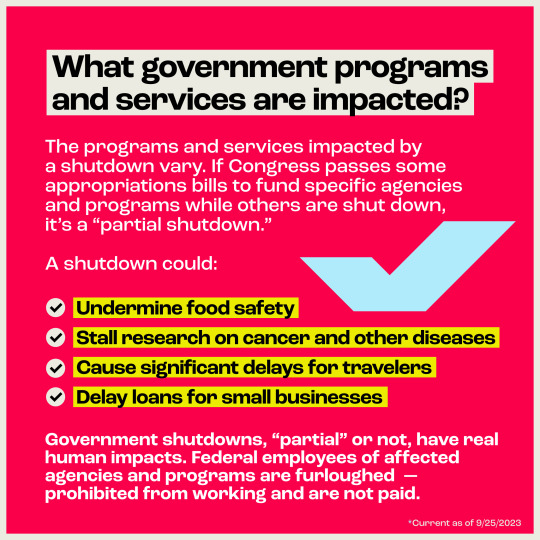



September 30th is the end of the fiscal year and the last day for Congress to fund the federal government. If funding isn’t passed, the government shuts down.
To date, the federal government has shut down 21 times, four times in the past 10 years. What does a government shutdown mean? Who’s impacted? What’s currently happening in Congress? Swipe through and remember, government shutdowns are impacted by your vote.
Check your voter registration at weall.vote/check and remind a friend to do the same.
5K notes
·
View notes
Text
The New York Times: Senate Approves Aid for Ukraine and Israel, Sending It to Biden's Desk
#the new york times#joe biden#u.s. congress#u.s. senate#u.s. politics#ukraine#ukraine aid#news#social issues
9 notes
·
View notes
Text
By Jake Johnson
Common Dreams
April 6, 2023
One observer urged congressional Democrats to "put Republicans on the record supporting this level of corruption, and make the corrupt judiciary a campaign issue."
Progressives on Thursday urged congressional Democrats to immediately push for investigations and impeachment proceedings after bombshell reporting by ProPublica revealed that right-wing Supreme Court Justice Clarence Thomas has been taking luxury trips funded by a billionaire Republican megadonor for more than 20 years without formally disclosing them—a likely violation of federal law.
The investigative outlet reported Thursday that "for more than two decades, Thomas has accepted luxury trips virtually every year" from Dallas-based real estate magnate Harlan Crow.
According to ProPublica, Thomas "has vacationed on Crow's superyacht around the globe. He flies on Crow's Bombardier Global 5000 jet. He has gone with Crow to the Bohemian Grove, the exclusive California all-male retreat, and to Crow's sprawling ranch in East Texas. And Thomas typically spends about a week every summer at Crow's private resort in the Adirondacks."
"These trips appeared nowhere on Thomas' financial disclosures," the outlet noted. "His failure to report the flights appears to violate a law passed after Watergate that requires justices, judges, members of Congress, and federal officials to disclose most gifts, two ethics law experts said. He also should have disclosed his trips on the yacht, these experts said."
Virginia Canter, a former government ethics lawyer who is now with the watchdog group Citizens for Responsibility and Ethics in Washington (CREW), told ProPublica that the justice "seems to have completely disregarded his higher ethical obligations."
"When a justice's lifestyle is being subsidized by the rich and famous, it absolutely corrodes public trust," said Canter. "Quite frankly, it makes my heart sink."
The luxury trip revelation is just the latest scandal for Thomas, who has faced mounting scrutiny over the past year for alleged ethics violations, including his decision not to recuse himself from cases involving the 2020 presidential election despite his wife's direct involvement in efforts to overturn the results of that contest.
"Democrats should force an impeachment vote of Justice Thomas on the House floor," Philadelphia Inquirer columnist Will Bunch argued Thursday in response to the ProPublica reporting. "It won't pass, obviously, but put Republicans on the record supporting this level of corruption, and make the corrupt judiciary a campaign issue."
It's unclear how House Democrats would go about forcing an impeachment vote given GOP control of the chamber. Republicans have repeatedly defended Thomas as he's faced backlash over his failure to recuse from election-related cases.
Brian Fallon, executive director of the advocacy group Demand Justice, said in a statement Thursday that the Senate—which is narrowly controlled by Democrats—"cannot let this extraordinary display of corruption and lawbreaking go unanswered."
"Senate Democrats cannot force Thomas to resign or give him the impeachment trial he clearly deserves, but they can hold hearings to further expose Justice Thomas’ apparent lawbreaking and the Republican justices' deep ties to far-right donors," said Fallon. "As long as we are stuck with a Supreme Court made up of corrupt idealogues in the pocket of far-right donors, the American people deserve to know the truth."
ProPublica stressed that "the extent and frequency of Crow's apparent gifts to Thomas have no known precedent in the modern history of the U.S. Supreme Court."
"Crow's access to the justice extends to anyone the businessman chooses to invite along," the outlet reported. "Thomas' frequent vacations at Topridge have brought him into contact with corporate executives and political activists. During just one trip in July 2017, Thomas' fellow guests included executives at Verizon and PricewaterhouseCoopers, major Republican donors, and one of the leaders of the American Enterprise Institute, a pro-business conservative think tank."
The outlet noted that a painting of Thomas at Topridge—Crow's private lakeside resort in upstate New York—shows Thomas "in conversation with Leonard Leo, the Federalist Society leader regarded as an architect of the Supreme Court’s recent turn to the right."
Sen. Sheldon Whitehouse (D-R.I.), the chair of the Senate Judiciary Courts Subcommittee and a vocal advocate of ethics reform on the high court, wrote on Twitter that ProPublica's reporting "cries out for the kind of independent investigation that the Supreme Court—and only the Supreme Court, across the entire government—refuses to perform."
"It's not just the undisclosed gifts of hospitality, it's the undisclosed company of political operatives—particularly Leonard Leo, the operative who helped the billionaires capture the court," Whitehouse continued. "Who were Thomas' companions on these free undisclosed vacations, and what interests did those undisclosed companions have before the court? The question is obvious."
"All of this needs robust investigation," the senator added, "and it's the chief justice's job to make sure that occurs."
#clarence thomas#u.s. supreme court#judicial ethics#impeachment#u.s. congress#call to action#propublica#common dreams
78 notes
·
View notes
Text
AN OPEN LETTER to THE PRESIDENT & U.S. CONGRESS; STATE GOVERNORS & LEGISLATURES
Stand Against Voter Disenfranchisement: Keep Voting Age Fair!
1 so far! Help us get to 5 signers!
I am writing to express my strong opposition to any efforts to increase the voting age to 21 or older. Recent proposals by some Republicans to raise the voting age are deeply concerning and would unjustly infringe upon the civic duties of legal adults.
It is important to remember that many of our nation's founding fathers, including James Monroe at 18, Aaron Burr at 20, Alexander Hamilton at 21, James Madison at 25, and more, were all young adults when they played pivotal roles in shaping our country. Denying young adults their right to participate in our democracy would contradict the very principles upon which our nation was founded. Would you have prevented these American legends knowing they were capable of greatness?
The notion that if someone is "old enough to fight, they are old enough to vote" holds true today. Young adults contribute to society in meaningful ways and deserve to have a say in the decisions that impact their lives and their futures. If 18-year-olds are fighting and dying for you, you must listen to their voices!
Furthermore, restricting voting rights disproportionately affects already disadvantaged minority voters. We should be working to include and strengthen our populace, including BIPOC Americans, reformed citizens seeking reintegration into society, and our extremely motivated youth. We must work to strengthen voting access for all American citizens, not limit it.
In the words of our American colonials who fought against their British rulers, "Taxation without representation is tyranny." Denying young adult Americans their right to vote would undermine the core principles of our democracy that we have held since day one.
I urge you to oppose any measures that seek to raise the voting age and instead support efforts to protect and expand voting rights for all eligible citizens.
Thank you for considering my perspective on this critical issue.
📱 Text SIGN PVTGSX to 50409
🤯 Liked it? Text FOLLOW IVYPETITIONS to 50409
💘 Q'u lach' shughu deshni da.
🏹 "What I say is true" in Dena'ina Qenaga
#IVYPETITIONS#PVTGSX#resistbot#open letter#U.S. PRESIDENT#U.S. CONGRESS#STATE GOVERNORS#state LEGISLATURES#Voter Disenfranchisement#Voting Age#James Monroe#Aaron Burr#Alexander Hamilton#James Madison#📱 Text SIGN PIYDKC to 50409#Founding Fathers#American History#Political Engagement#Minority Voters#BIPOC Americans#Civil Rights#Representation#Social Justice#Equality#Government#Political Participation#Youth Vote#Citizenship#Democratic Principles#Election Reform
5 notes
·
View notes
Text

André-Philippe Côté, Le Soleil (Québec) ::[Scott Horton]
* * * *
Volodymyr’s triumph, Vladimir’s humiliation. :: December 22, 2022
Robert B. Hubbell
On Wednesday, the presidents of Ukraine and Russia addressed the world about the existential struggle between the nation of Ukraine and the tyrant of Russia. The Ukrainian leader spoke with strength and confidence to a US Congress momentarily united by a man whose manifest courage melted partisan divides and galvanized the reluctant hearts and minds of wary politicians. Volodymyr Zelenskyy’s address to Congress was a triumph for Zelenskyy, Ukraine, and the global defense of democracy.
The video of the speech is here; President Zelenskyy Address to Congress (beginning at the 35-minute mark). I urge you to watch the address in its entirety.
On the opposite side of the globe, the tyrant of Russia was forced to concede that his depraved assault on the Ukrainian people has been a disaster for the Russian military. Putin delivered his remarks to the Russian Parliament, whose members are political hostages that dare not speak the truth about Putin’s blunder. But the blood of dead and wounded soldiers returning to small towns and villages across Russia has seeped through the warp and weft of Putin’s shroud of censorship.
In his speech, Putin boasted of materials and support that will be provided to Russian soldiers in the future—an admission that those items are in short supply among troops already deployed in Ukraine. The list of missing items is pathetic sign of a shocking lack of military preparedness in Russia’s once-vaunted army: boots, food, helmets, medical kits, and bulletproof vests. See NYTimes, Putin Concedes Military Failings, but Insists Russia Will Fight On. Putin’s promise to provide better equipment and training for troops engaged in combat is like promising to repair a Boeing 747 mid-flight. It can’t be done.
Zelenksyy’s visit to Washington was remarkable and historic. It is beyond my ability to summon relevant comparisons. I will leave that commentary to historians and give you my real-time impressions of Zelenskyy’s speech. (The quotations below are based on notes and may not track the official transcript.)
The essential fact is this: Zelenskyy is a masterful communicator and a charismatic, courageous leader. He entered the House chamber bearing a battle flag signed by Ukrainian soldiers deployed on the front lines. He presented that flag to Congress as a symbol of Ukraine’s gratitude. He left the chamber holding an American flag given to him by Speaker Pelosi as a sign of America’s respect for Zelenskyy and Ukraine. If that were all that had happened, it would have been a diplomatic triumph. But there was so much more.
The House was packed with Representatives and Senators otherwise distracted by last-minute negotiations over the 2023 appropriations bill. To their credit, members of Congress gave Zelenskyy dozens of standing ovations accompanied by cheers. For once, Republicans and Democrats were united in common purpose. (The exceptions were Matt Gaetz and Lauren Boebert, who remained seated beside each other, smirking and whispering while their colleagues applauded Zelenskyy.)
Zelenskyy delivered his speech in English, a powerful yet endearing effort to speak directly to Americans at an emotional level. It worked. At least it worked for me. In earnest tones and plain words, Zelenskyy spoke of the suffering of the Ukrainian people. But he said that Ukrainians do not feel sorry for themselves or resent those not facing similar challenges. In a moving passage, he spoke about celebrating Christmas by candlelight, not by choice but because Iranian-supplied drones had targeted the electrical grid. Zelensky said,
In two days, we will celebrate Christmas by candlelight. Millions will have no heating or running water as a result of missiles and drone attacks on infrastructure. We do not complain; we do not judge or compare whose life is easier; your well-being is the product of your many struggles and victories. We will go through our war with dignity and success.
Zelenskyy spoke of America and Ukraine as allies in a global fight against anti-democratic forces. (“Our two nations are allies in the battle.”) He said that the struggle “will define in what world our children and grandchildren will live. Will it be a democracy of Ukrainians and Americans?” And Zelensky cautioned that America should “not make the mistake of believing that an ocean will protect America because the world is too interconnected to allow anyone to feel safe.”
Zelensky invoked American history. He compared the early battlefield success of Ukraine to the Battle of Saratoga, a decisive victory for the Continental Army in the Revolutionary War. He quoted the words of Franklin D. Roosevelt after Pearl Harbor, saying that Ukraine would “fight through to absolute victory.” He said that “Just as brave American soldiers fought Hitler’s forces during Christmas 1944, so Ukrainian troops are fighting Russia this Christmas.”
Zelenskyy sought to put Putin on the defensive. He said that Ukraine had already won the battle for the hearts and minds of the world. And he warned that the war might not end until Russians had freed themselves of control by the Kremlin.
Finally, Zelensky called for unity in Congress (“bi-partisan and bi-cameral”). He assured the lawmakers that Ukrainians did not need American troops but instead needed additional military and financial aid. In a memorable line, he said that “Your money is not charity; it is an investment in global security that we will handle in the most responsible way.”
The speech was remarkable, brave, and historic. Professor Timothy Snyder of Yale provided his thoughts on Lawrence O’Donnell’s show, explaining why and how Ukraine’s defense against Russia benefits America far beyond the military and financial support we provide to Ukraine. Snyder made similar remarks in his Substack newsletter, Gratitude to Ukraine - by Timothy Snyder. I have previously linked to Snyder’s essay on gratitude to Ukraine. If you haven’t read it, now is a good time to do so.
In the end, the most important part of Zelenskyy’s speech is that it reminds Americans of the sacrifice necessary to defend democracy—one that prior generations willingly made for us. We should not take that sacrifice for granted nor defile it by turning our backs on liberties redeemed with blood and suffering. Today’s challenges are daunting, but it is our duty to overcome them. To do so, we must embrace the example of courage and determination on display on the floor of the House chamber today. Today, all Americans should join in saying, “Slava Ukraini!”
[Robert B. Hubbell Newsletter]
#Robert B. Hubbell Newsletter#Robert B. Hubbell#War in Ukraine#Volodymyr Zelensky#André-Philippe Côté#Le Soleil#Scott Horton#Address to Congress#U.S. Congress
25 notes
·
View notes
Link
“ ... Oh the misogyny! Oh the Islamophobia! Oh the racism! The Republican party has hit the trifecta of ignorance. A party rife with anti-Semites and anti-Semitism has the chutzpah to tell the American people that they’re expelling Rep. Ilan Omar from the House foreign affairs committee because she’s an anti-Semite? Oh and did I mention they accused her of being a terrorist? Tried to tie her to the 9/11 attacks?
Speaking of anti-Semites: their own leader and current Speaker, Kevin McCarthy accused three Jewish financiers of “buying the election.” ...”

15 notes
·
View notes
Text
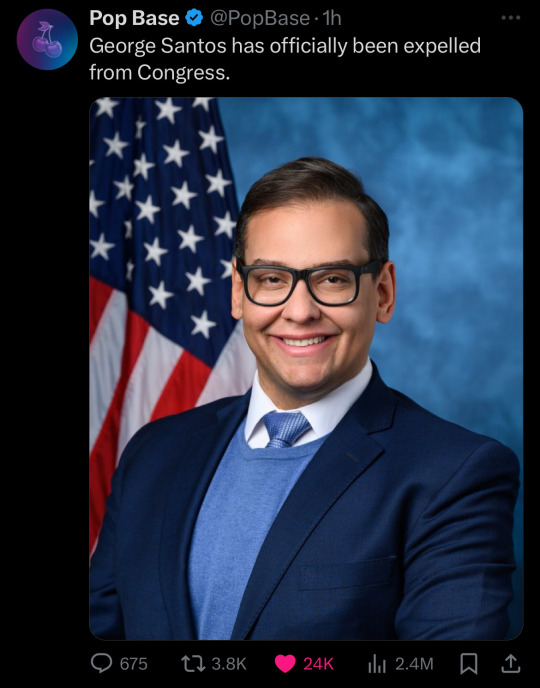




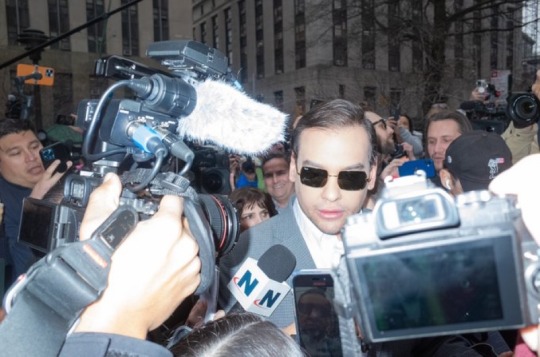
It’s a miracle that this man stayed in office for so long lmao
Also I’m sorry but that last photo is serving cunt
#george santos#congress#u.s. congress#wicked#twitter#american politics#the united states of america#america
2 notes
·
View notes
Link
17 notes
·
View notes
Text
Now begins the summer of our discontempt
#Congress#U.S. Congress#appropriations bills#spending bills#federal spending#FY2024#U.S. government#government funding#12 weeks left#Government Shutdown?
3 notes
·
View notes
Text
Working Hard To Take Away Our Vote
Working Hard To Take Away Our Vote
For a while over the last two years, our attention was focused on voting rights. After the false claims of voter fraud in the 2020 election, states – particularly predominantly Republican states – used the claims as an excuse to pass restrictive laws, allegedly to make elections more secure, but in reality, to disenfranchise the sort of voters who are more likely to vote for Democrats. These…

View On WordPress
#Freedom to Vote Act#Heritage Foundation#John Lewis Voting Rights Act#Robert Spindell#U.S. Congress#voter disenfranchisement
9 notes
·
View notes
Text

#black america#Barbara Jordan#Black woman#Smile#u.s. congress#Black congresswoman#black history#black history month#Texas
6 notes
·
View notes
Text

Tina Cordova and her mother, Rosalie, relax at Bonito Lake, New Mexico, in 1960. Cordova says the lake—which lies within the estimated radioactive fallout zone—was a water source for area towns, including Carrizozo, Alamogordo, and Ruidoso. Courtesy of Anastacio and Rosalie Cordova
U.S. Lawmakers Move Urgently to Recognize Survivors of the First Atomic Bomb Test
The 1945 Trinity test produced heat 10,000 times greater than the surface of the sun and spread fallout across the country.
— By Lesley M.M. Blume | Published September 21, 2021 | July 29th, 2023
Barbara Kent joined Carmadean’s dance camp in the desert near Ruidoso, New Mexico, in the summer of 1945. During the day, she and nine other girls learned tap and ballet. At night, they slept in a cabin by a river. Early in the morning on July 16, 1945, Kent says that she —then 13—and the other campers were jolted out of their bunk beds by what felt like an enormous explosion nearby. Their dance instructor rushed the girls outside, worried that a heater on the premises might have burst.
“We were all just shocked … and then, all of a sudden, there was this big cloud overhead, and lights in the sky,” Kent recalls. “It even hurt our eyes when we looked up. The whole sky turned strange. It was as if the sun came out tremendous.”
A few hours later, she says, white flakes began to fall from above. Excited, the girls put on their bathing suits and, amid the flurries, began playing in the river. “We were grabbing all of this white, which we thought was snow, and we were putting it all over our faces,” Kent says. “But the strange thing, instead of being cold like snow, it was hot. And we all thought, ‘Well, the reason it’s hot is because it’s summer.’ We were just 13 years old.”
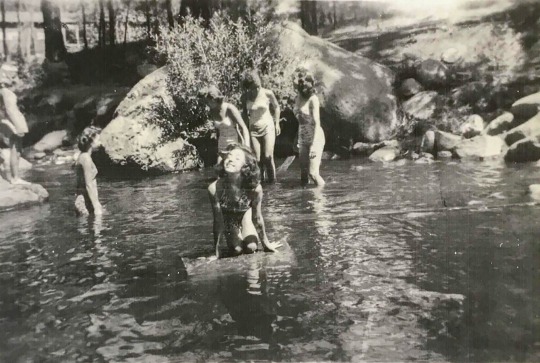
Thirteen-year-old Barbara Kent (center) and her fellow campers play in a river near Ruidoso, New Mexico, on July 16, 1945, in the hours after the bomb’s detonation. Fallout flakes drifted down that day and for days afterward. “We thought [it] was snow," Kent says. “But the strange thing, instead of being cold like snow, it was hot." Courtesy of Barbara Kent
The flakes were fallout from the Manhattan Project’s Trinity test, the world’s first atomic bomb detonation. It took place at 5:29 a.m. local time atop a hundred-foot steel tower 40 miles away at the Alamogordo Bombing and Gunnery Range, in Jornada del Muerto valley.
The site had been selected in part for its supposed isolation. In reality, thousands of people were within a 40-mile radius, some as close as 12 miles away. Yet all those living near the bomb site weren't warned that the test would take place. Nor were they evacuated beforehand or afterward, even as radioactive fallout continued to drop for days.
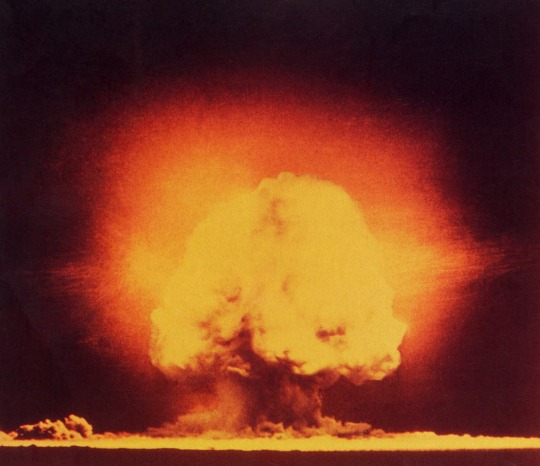
The Trinity test took place at 5:29 a.m. local time on July 16, 1945. It was three to five times more powerful than its creators had anticipated, producing heat 10,000 times greater than the surface of the sun. The explosion cloud may have reached a height of 70,000 feet. Photograph By Science History Images/ Alamy
In 1990, the U.S. Congress passed the Radiation Exposure Compensation Act (RECA), which has since dispensed over two billion dollars to more than 45,000 nuclear workers and “downwinders”—a term describing people who have lived near nuclear test sites conducted since World War II and may have been exposed to deadly radioactive fallout.

But those exposed during the Trinity test and its aftermath have never been eligible.
For years, Senator Ben Ray Lujan, a Democrat from New Mexico, and other members of Congress have attempted to amend RECA, due to expire on July 11, 2022. In light of this looming deadline, on September 22, Lujan, along with Senator Mike Crapo, Republican of Idaho, and eight co-sponsors introduced Senate bill S. 2798 to extend RECA and expand it to make those in the estimated Trinity fallout zone eligible, as well as other downwinder communities in Colorado, Idaho, and Montana. The proposed legislation also would expand eligibility for people who have worked in uranium mines and mills or transported uranium ore. Also on September 22, Representative Teresa Leger Fernandez and 15 co-sponsors introduced a similar bill, H.R. 5338, in the House.

The plutonium bomb—nicknamed the Gadget—was set atop this hundred-foot steel tower, which vaporized in the explosion. "From the Trinity test,” a 2010 Centers for Disease Control and Prevention report noted, “it was learned that detonating a nuclear explosive device [that] close to the ground increases the radioactive fallout from the event." Photograph Via CORBIS/Getty
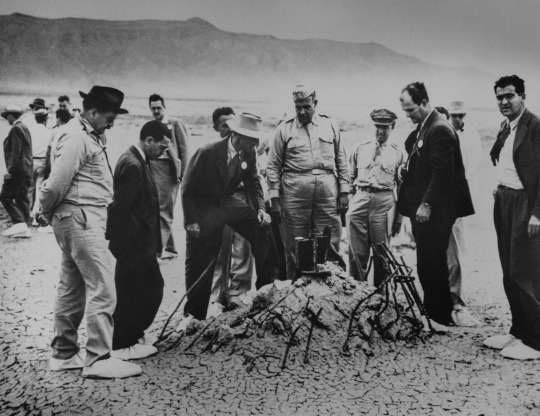
Manhattan Project leaders—including General Leslie Groves (center) and, to his right, physicist J. Robert Oppenheimer—scrutinize the remnants of the tower at ground zero. Upon seeing the detonation, Oppenheimer thought of a line from the Bhagavad Gita: "Now I am become Death, the destroyer of worlds." Photograph Via CORBIS/Getty
“The fact that there had not been a recognition of the impact of the very first atomic detonation in New Mexico was really simply wrong,” says Representative Teresa Leger Fernandez, a Democrat from New Mexico and co-sponsor of the House bill. “We hear their voices, we see their pain, and we must act.”
This is an especially urgent and consequential moment for those living in Trinity’s estimated fallout zone—some of whom have been waiting 76 years to be acknowledged. “We have been denied justice long enough,” says Bernice Gutierrez, who was a newborn when the bomb exploded. Her family lived in Carrizozo, about 50 miles from the blast site. “It’s not like we haven’t given our all to our country. What more can you give?”
‘A Very Serious Hazard’
The blast from the plutonium implosion device, nicknamed the Gadget, produced heat 10,000 times greater than the surface of the sun and was significantly more powerful than its creators had expected. It carried aloft hundreds of tons of irradiated soil and sent a mushroom cloud up to 70,000 feet in the sky. In this experimental atomic detonation, only three of the 13 pounds of plutonium at the bomb’s center underwent fission. The rest dispersed in the fallout cloud.
A tiny fraction of that three pounds of plutonium—about the weight of a raisin—was enough to release “three times the destructive force of the largest conventional bomb used in World War II,” says Robert Alvarez, associate fellow at the Institute of Policy Studies and former senior policy advisor to the U.S. Secretary of Energy. (The Gadget released an explosive force equivalent to about 21,000 tons of TNT.)
Right after detonation, the cloud divided into three parts. One part drifted east, another to the west and northwest, and the rest to the northeast, across a region a hundred miles long and 30 miles wide, “dropping its trail of fission products” the entire way, according to a 2010 report by the Centers for Disease Control and Prevention (CDC). The fallout eventually spread over thousands of square miles and was detected as far away as Rochester, New York.
Nineteen counties in New Mexico were in the downwind area, including 78 towns and cities, and dozens of ranches and pueblos. Radiation levels near homes in some “hot spots” reached levels “almost 10,000 times what is currently allowed in public areas,” according to the CDC.
“There is still a tremendous quantity of radioactive dust floating in the air,” wrote Stafford Warren to U.S. Army General Leslie R. Groves, head of the Manhattan Project, five days after the blast. Warren, the project’s chief medical officer, added that “a very serious [radiation] hazard” existed within a 2,700-square-mile area downwind of the test.
He also advised that future atomic tests be done only where there were no people within a radius of 150 miles. (Nearly half a million people in New Mexico, Texas, and Mexico lived within a 150-mile radius of the Trinity test.)
“We didn’t know what the hell we were doing,” Louis Hempelmann—the director of the Los Alamos Health Group, a team tasked with managing radiation within the Manhattan Project—reflected in a 1986 interview uncovered by sociologist James L. Nolan, Jr., in his book Atomic Doctors. “Nobody had had any experience like this before, and we were just hoping that the situation wouldn’t get terribly sticky.”
The leaders of the Manhattan Project knew that civilians had been “probably overexposed,” Hempelmann said. “But they couldn’t prove it and we couldn’t prove it. So we just assumed that we got away with it.”
Many civilians living within the estimated fallout zone were unwittingly exposed and sickened. According to Alvarez, even minute quantities of plutonium can inflict disease. “Particles of plutonium less than a few microns in diameter can penetrate deep in the lungs and lymph nodes and can also be deposited via the bloodstream in the liver, on bone surfaces, and in other organs,” he says. “If inhaled, extremely small amounts can lead to cancer.”
How is it, asks Senator Lujan, that RECA covered people living downwind of the Nevada Test Site but left out “the community where the first nuclear bomb was tested on American soil? There’s not been a good answer given to me nor to the downwinders in New Mexico. There’s no question of the exposure that resulted from the Trinity test.”
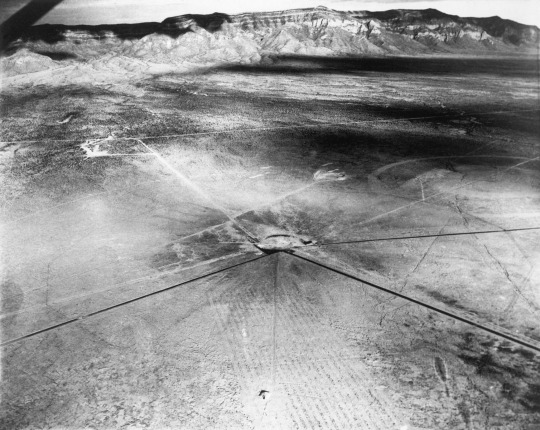
The explosion seared the desert sand surrounding the tower into a green, glass-like substance, named Trinitite. Photograph Via Bettmann/Getty
Something Felt Terribly Awry
Several people living near the test site later reported that they thought they were experiencing the end of the world. The strange, snowlike substance that fell from the sky for days coated everything: orchards, gardens, livestock, as well as cisterns, ponds, and rivers—the main sources of drinking water because local groundwater was “unsuitable for human consumption,” according to the 2010 CDC report.
One family in Oscuro, New Mexico, about 45 miles from the site, hung wet bedsheets in their windows against the fallout. They felt that something was terribly awry when their chickens and their dog died. Thirty miles away from ground zero, along Chupadera Mesa, burns appeared on the hides of cattle, whose fur eventually grew back gray and white in the burned patches.
A health care provider in Roswell, a hundred miles away, noted a surge in infant deaths there—35 in August 1945 alone. When she wrote to Warren, stating her concerns, his medical assistant replied that there were no “pertinent data” and assured her that “the safety and health of the people at large is not in any way endangered.”
“They Lied To Us. I Didn’t Learn The Truth Until Years Later.” — BatbaraKent, Trinity Test Survivor
For General Groves, getting the bomb ready—in secrecy—for wartime use had trumped all other considerations, including public safety.
Yet he realized that a blast whose flash was seen in at least three states and two countries could not be wholly concealed. He ordered the commanding officer of the Alamogordo Air Base to feed a cover story to the Associated Press that “a remotely located ammunition magazine containing a considerable amount of high explosives and pyrotechnics exploded.” There had been, the report went on, “no loss of life or injury.” Local newspapers reprinted the announcement without challenge.
Barbara Kent recalls that the day after the explosion, her camp’s dance instructor took the girls into Ruidoso, where government officials were to make an announcement about the source of the blast.
“It was so crowded downtown—everyone was shoulder to shoulder,” Kent says. “What they told us—there was an explosion at a dump. They said, ‘No one worry about anything, everything’s fine, just go along with your own business.’ Everyone was confused. Some people believed it, but some people thought they couldn’t imagine that a dump explosion would do this." She continues: "They lied to us. I didn’t learn the truth until years later.”
As time passed, Kent says she began to hear disturbing reports that her fellow campers were falling ill. By the time she turned 30, she says, “I was the only survivor of all the girls at that camp.” She adds that she has suffered from lifelong illnesses: She had to have her thyroid removed and has survived several forms of cancer, including endometrial cancer and “all kinds of skin cancers.”

In this photograph from 1962, three-year-old Tina Cordova (bottom right) is pictured with her father, Anastacio (holding her baby brother, Matthew), and mother Rosalie. The young family lived in Tularosa, about 40 miles from the blast site. Everything they ate, Tina recalls, “was raised or grown or hunted," adding that the bomb’s “ash got everywhere, in the soil, in the water—everything was contaminated." She says her mother and father developed cancers, and she was diagnosed with thyroid cancer when she was 39. Courtesy of Anastacio and Rosalie Cordova
Tina Cordova is a fifth-generation resident of Tularosa, about 40 miles from the blast site. Thanks to an extensive ditch system in the area, the town was an oasis in the desert, and Cordova’s family’s home, like many others, had an orchard and garden.
“You could literally go out into your yard in the summer and eat peaches, apricots, cherries, figs, dates, pecans, walnuts—everything you could think of,” she says. Local people harvested and canned their fruit and collected rainwater for drinking from rooftop cisterns. Milk came from local dairies. People made their own butter and butchered farmyard animals or hunted wild animals for meat, including deer, quail, rabbit, and pheasant.
“Everything that people were consuming in 1945 was contaminated,” Cordova says. “But they didn’t know [the fallout was] dangerous. They went about their lives.”
After the test, she says, health problems began to plague her family, all of whom lived in and around Tularosa. According to Cordova, two of her great-grandfathers died of stomach cancer, and both of her grandmothers developed cancer. Two aunts had breast cancer, and one died from it. A cousin developed a brain tumor. Her mother had mouth cancer, and her sister has skin cancer. Her father, who was four at the time of the blast, suffered from various cancers, including prostate cancer and tongue cancer. Doctors had to remove part of his tongue and his lymph nodes. The cancer eventually spread to his neck and became inoperable. Cordova says he weighed about 125 pounds at his death in 2013 at the age of 71. She says that she herself was diagnosed with thyroid cancer in 1997, when she was 39.
‘When Are They Going To Hold Our Government Accountable?’
After the U.S. leveled Hiroshima with a uranium bomb on August 6, 1945, the secret history of the creation of atomic weapons was released and widely publicized. Many New Mexicans now realized that the blast that had shattered their windows and blanketed their homes in warm ash was not, after all, an ammunition dump explosion. Although they still hadn't been informed by the government about the nature of that ash or monitored for adverse health effects, they were encouraged to be proud of the part they’d unknowingly played in bringing about the dramatic new atomic age.
“When I was a child, the government fed us propaganda about how much pride we should take in the part we played in ending World War Two,” Cordova says. “We still did not know what that meant from a health consequence perspective. Our mom actually took us to the [Trinity] site for a picnic. We brought home as much Trinitite as we could and played with it.” (The Trinity Site is now a National Historic Landmark, open to visitors twice a year, and anyone can go online and buy radioactive fragments of Trinitite—a green glass created from sand and other materials that melted in the immediate blast zone.)

The U.S. Army erected this monument at ground zero in 1965. Ten years later, the National Park Service designated Trinity Site as a National Historic Landmark. It’s open to visitors twice a year, on the first Saturdays in April and October. Photograph By Tony Korody, SYGMA Via Getty
In 2004, Cordova read a letter from another Tularosa resident, Fred Tyler, to the editor of a local newspaper. She says that the letter changed her life. “He said, ‘When are they going to hold our government accountable for the damage they did to us?’ ” Cordova says. “I called him and said, ‘I feel the same way you do. It’s time to start an organization to more fully push the government about this issue.’ ”
In 2005, Cordova and Tyler founded the Tularosa Basin Downwinders Consortium (TBDC) as an advocacy organization for Trinity test downwinders.
At that time, she recalls, they weren’t aware that the Radiation Exposure Compensation Act had been in place for 15 years and already had provided onetime, $50,000 compensation to other downwinders who “may have developed cancer or other specified diseases after being exposed to radiation from atomic weapons testing or uranium mining, milling, or transporting.” Downwinder eligibility initially was limited to those within specified areas around the Nevada Test Site, 65 miles north of Las Vegas, where a hundred aboveground tests were conducted before a moratorium on atomic testing took effect in 1992.
In 2000, an amendment to RECA expanded eligibility to include some uranium miners and millers in New Mexico. Military and government workers who were “on-site participants” in the Trinity test were also eligible for compensation, but civilian downwinders remained ineligible.
Cordova, like Senator Lujan, says she has “never been able to get a straight answer” about why civilian downwinders were excluded from the legislation: “Even from people who were serving in Congress at the time, I’ve been told, ‘Well, no one was connecting the dots that anybody was harmed.’ ”
Bill Richardson—a Democrat who served as New Mexico’s governor from 2003 to 2011 and was a representative for the state’s Third Congressional District in 1990 when RECA was enacted—says, “I don’t think there was opposition [to their inclusion], just perhaps a lack of awareness. I didn’t know about their claims until I started reading about it when I was governor, and I was sympathetic.”
To raise awareness, Cordova and her colleagues at the consortium began to gather testimonies from and distribute health surveys to downwinders who were alive at the time of the Trinity test, along with their descendants who have lived in areas surrounding the test site. To date, the consortium has collected more than 1,000 surveys, and Cordova says that 100 percent of those questioned describe adverse health conditions—from thyroid disease to brain cancer—that can result from radiation exposure. Often participants describe similar cancers that have ravaged many family members over several generations.
‘A Now-or-Never Moment’
Cordova describes this effort to extend and expand RECA as a “now-or-never moment.” Senator Mike Crapo, an Idaho Republican and co-sponsor of the Senate bill, says there’s a “dire need for Congress to extend RECA … [and] to include victims in states across the West.”
“It is beyond time for the federal government to right a past wrong that caused harm to countless innocent Americans,” he wrote in a letter on March 24, 2021, to the chairman and members of the House Judiciary Committee.
“We Hear Their Voices, We See Their Pain, and We Must Act.” — TeresaLeger Fernandez, Representative to Congress, New Mexico
“When [RECA] was first introduced, no one considered the impact on the first downwinders,” Representative Fernandez says. “But we are in a place now where we recognize an injustice when we see it.” Her family lived in San Miguel and Guadalupe Counties in New Mexico, areas of potential exposure. She says her mother and sister—both nonsmokers—died of lung cancer. Her father died of esophageal cancer, she says, and her grandmother, who grew up near the Trinity site, died of leukemia.
Fernandez and Lujan say they’re also going to push for new epidemiological and environmental studies of the Trinity test’s aftermath and possible long-term effects.
Assessing Trinity’s exact “fingerprint” based on current fallout levels is “complicated and subject to large uncertainties,” says health physicist Joseph Shonka, co-author of the 2010 CDC report. He notes that residents of New Mexico have higher positive plutonium levels in their tissues than residents of any other state but says that tracing those levels back specifically to Trinity fallout might be difficult.
New Mexicans also may have internalized plutonium from various additional sources, he says, including general global fallout, releases from New Mexico’s Los Alamos plutonium operations, and fallout that drifted down from Nevada’s Test Site. The CDC recommended prioritizing Trinity’s aftermath for future studies.
Last year, the National Cancer Institute (NCI) released its findings from a nearly seven-year study of the Trinity nuclear test. The study’s lead investigator, Steven Simon, calls it the “most comprehensive study conducted on the Trinity test and its possible ramifications for cancer risks in the estimated fallout area.”
The researchers concluded that up to a thousand people may have developed cancer from the Trinity test fallout and that “only small geographic areas immediately downwind to the northeast received exposures of any significance.” They also said that the “plutonium deposited as a result of the Trinity test was unlikely to have resulted in significant health risks to the downwind population.”
The researchers also acknowledged their study’s limitations. Calculating exposure for those alive at the time of the detonation is “complex and is subject to uncertainties,” Simon explains, “because all of the needed data is not available."
Shonka says the new NCI study “failed to address early fallout adequately.” He says he questions some of the methodology and is preparing a counter-article addressing what he says are inconsistencies with previous findings. Other critics of the NCI study say it doesn’t address ongoing family cancer clusters and the reported 1945 spike in infant deaths in the region, documented in a 2019 paper in the Bulletin of the Atomic Scientists, co-authored by Robert Alvarez.
The NCI responds that its researchers focused on exposures received among “New Mexico residents alive at the time of the test,” and that they didn’t investigate the infant mortality because it was “not a cancer effect.”
Senator Lujan calls the NCI study “limited” and says that he wants to “make sure that there’s accurate data that truly is looking at the exposure that families face.”
“How can someone say that families in proximity to a nuclear blast were not exposed?” he asks. “It goes against everything that I’ve learned and data sets that I’ve seen from different parts of the world where this has happened, whether it’s been from meltdown of nuclear energy generation facilities or where weapons were deployed.”
Lujan continues, “People died as a result of the Trinity test—that’s a fact. People are still suffering—that’s a fact. The U.S. needs to come forward to address this liability, this wrong.”
Cordova says she and her community will be closely watching the RECA bills’ progress. The new legislation asks to expand compensation for individuals from $50,000 to $150,000. But beyond financial restitution, Cordova says, they’re also hoping simply for a government apology.
“We’ve never had an opportunity to live normal lives,” she says. “They can never say that they didn’t know ahead of time that radiation was harmful or that there was going to be fallout. We don’t ask if we’re going to get cancer; we ask when it’s going to be our turn. We are the forgotten collateral damage.”
— Lesley M. M. Blume is a New York Times best-selling historian, journalist, and author of Fallout: The Hiroshima Cover-up and the Reporter Who Revealed It to the World.
#United States 🇺🇸#US Lawmakers#Atomic Bomb 💣#Survivors#Lesley M.M. Blume#Barbara Kent#Ruidoso New Mexico#Manhattan Project’s Trinity Test#Alamogordo Bombing and Gunnery Range#Jornada del Muerto Valley#U.S. Congress#Radiation Exposure Compensation Act (RECA)#Two Billion Dollars 💵#Downwinders#New Mexico’s Senator Ben Ray Lujan (D)#Senator Mike Crapo (R—Idaho)#Rep. Teresa Leger Fernandez#Colorado Idaho and Montana#General Leslie Groves#J. Robert Oppenheimer#Serious Hazard#Louis Hempelmann#Los Alamos Health Group#Sociologist James L. Nolan Jr.#Terribly Awry#Government Accountable#Trinity Site#National Historic Landmark#Bill Richardson Governor New Mexico (D)
2 notes
·
View notes
Text
youtube
Pete Buttigieg SHUTS DOWN Marjorie Taylor Greene in must-see takedown
Brian Tyler Cohen
Dec. 27, 2023
INTERVIEW: Brian interviews Secretary of Transportation Pete Buttigieg about the Republicans’ sham impeachment effort against Joe Biden and some huge wins that this administration has racked up recently in the climate and transportation space.
#u.s. congress#pete buttigieg#marjorie taylor greene#republicans#congressional republicans#biden impeachment#Youtube
10 notes
·
View notes
Text
AN OPEN LETTER to THE U.S. CONGRESS
Hold Bank Execs Financially Accountable for Mismanagement! Pass the DEPOSIT Act.
274 so far! Help us get to 500 signers!
I am writing to urge you to pass the Deliver Executive Profits on Seized Institutions to Taxpayers (DEPOSIT) Act that was recently introduced by Sen. Richard Blumenthal and U.S. Reps Adam Schiff (D-CA) and Mike Levin (D-CA).
This important legislation would hold executives at failed banks financially responsible for their mismanagement and prevent them from selling off shares of stock, potentially profiting from their bank failure -- like Silicon Valley Bank CEO Greg Becker might have done when he sold $3.6 million of stock shortly before the collapse of SVB.
American taxpayers shouldn’t be left holding the bag and bailing out banks while their executives are walking away with multi-million dollar compensation and bonus packages. Please respond in writing and let me know you co-sponsored this bill. Thanks!
▶ Created on March 24, 2023 by Jess Craven
📱 Text SIGN PNFKGB to 50409
🤯 Liked it? Text FOLLOW JESSCRAVEN101 to 50409
#AN OPEN LETTER to THE U.S. CONGRESS#Hold Bank Execs Financially Accountable for Mismanagement! Pass the DEPOSIT Act.#274 so far! Help us get to 500 signers!#Deliver Executive Profits on Seized Institutions to Taxpayers (DEPOSIT) Act#Sen. Richard Blumenthal#Adam Schiff#Mike Levin#Silicon Valley Bank#CEO Greg Becker#holding the bag#bailing out#multi-million dollar compensation#bonus packages#▶ Created on March 24 2023 by Jess Craven#📱 Text SIGN PNFKGB to 50409#🤯 Liked it? Text FOLLOW JESSCRAVEN101 to 50409#JESSCRAVEN101#PNFKGB#resistbot#U.S. Congress#DEPOSIT Act#bank executives#financial accountability#mismanagement#legislation#accountability#taxpayer protection#banking industry#executive responsibility#financial regulation
2 notes
·
View notes
Photo

#congressman kaiali'i kahele#representative mary peltola#representative sharice davids#house of representatives#fuck yeah#u.s. congress
10 notes
·
View notes
Text
The New Republic: Elizabeth Stoker Bruenig: 'House GOP, White House Budget Overuse The Word Taxpayers'
Source: The New Republic– if TNR had their way, Tax Day would be a national holiday that they and other Socialists would celebrate.
“Earlier this week, House Republicans released their budget for the 2016 fiscal year, “A Balanced Budget for a Stronger America.” There is much to criticize in it, including deep cuts to social spending, questionable accounting, increasingly quixotic Obamacare repeal…

View On WordPress
#114th Congress#2015#America#Elizabeth Stoker Bruenig#Far Left#House Republicans#New Left#Political Correctness#Republican Party#Socialism#Socialists#Tax Day#Taxes#U.S. Congress#U.S. Government#U.S. House of Representatives#United States
3 notes
·
View notes